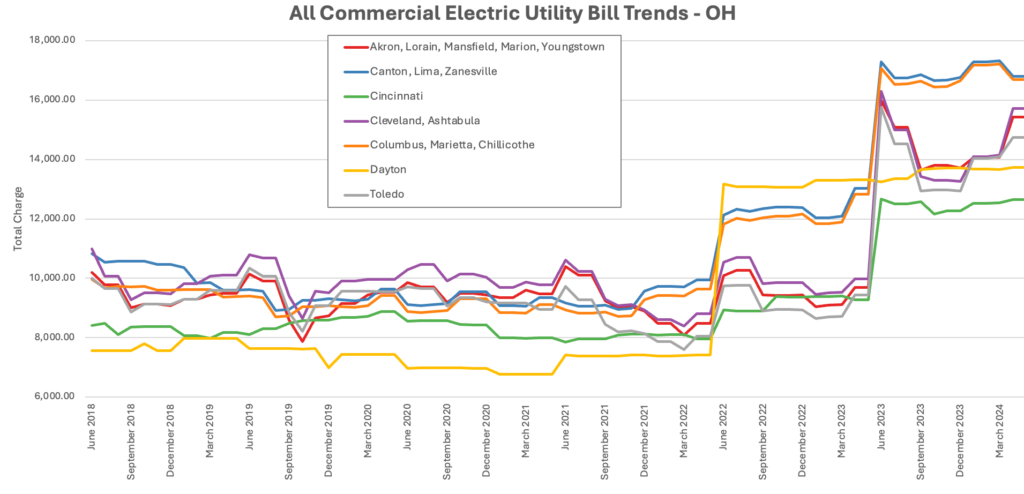In today’s business landscape, managing operational costs is key to staying competitive, and utility rates are becoming an increasingly unpredictable part of that equation. As a decision-maker—whether you’re a CEO, CFO, COO, or Facilities Manager—it’s essential to understand how volatile electricity pricing can impact your company’s financial health.
This post will dive into the factors contributing to utility rate volatility, explore what businesses can expect moving forward, and highlight the financial risks of delaying a switch to solar energy. By the end, you’ll see why now is a critical time to consider solar—not just as a sustainability measure, but as a strategic way to protect your bottom line from rising and uncertain energy costs.
Current Trends in Electric Rates

Electricity rates have been steadily climbing across the U.S., and that trend shows no sign of slowing down. Businesses—especially those in energy-intensive industries—are seeing the effects on their bottom line. But the bigger challenge isn’t just that rates are rising; it’s that they’ve become increasingly unpredictable.
While the long-term trend has historically pointed upward, year-to-year volatility makes budgeting for energy costs a growing challenge. Some years may bring moderate increases, while others deliver sharp spikes due to factors outside your control. And to make things even more complicated, rate trends vary by region—what’s happening in Michigan may look very different from Illinois or Pennsylvania.
This unpredictability is driven by a range of forces, including aging infrastructure, global fuel market instability, electrification trends like EV adoption, extreme weather events, and shifting energy regulations. For businesses, that means one thing: energy costs are becoming harder to predict and more expensive to ignore.
Without a plan to manage these growing and fluctuating costs, businesses could face significant financial strain—especially in industries where electricity is a major operational expense.
Factors Contributing to Rising Electric Rates

Understanding the factors behind rising electricity rates is key to anticipating future expenses and developing strategies to mitigate these costs. Several key elements are driving electricity rates higher, making it essential for businesses to stay informed and plan accordingly. Two major contributors to these increases are rising fuel costs and infrastructure investments.
Increased Fuel Costs
One of the primary reasons electricity rates are climbing is the rising cost of fuel, particularly natural gas. As a major source of electricity generation in the U.S., natural gas prices directly impact the cost of producing electricity. Over the past several years, fluctuations in global fuel markets have led to sharp increases in natural gas prices, which are passed on to businesses and consumers in the form of higher utility bills.
For commercial and industrial businesses that rely heavily on electricity, even a modest increase in fuel costs can significantly affect operational budgets. As fuel prices continue to rise due to geopolitical tensions, supply chain disruptions, and increased global demand, the ripple effect on electricity costs is expected to persist. This means businesses should be prepared for the ongoing impact of fuel price volatility on their electricity expenses.
Infrastructure Investments
Another significant factor contributing to higher electricity rates is the growing need for infrastructure investments. The aging power grid in many regions requires constant maintenance and upgrades to ensure reliability, efficiency, and compliance with new regulations. From replacing old transmission lines to modernizing substations, these upgrades are essential to meet the increasing demand for electricity and integrate renewable energy sources.
However, these necessary improvements come at a cost. Utility companies pass the expenses of these infrastructure projects down to consumers in the form of higher rates. While these upgrades are crucial for ensuring long-term energy security and reducing the risk of outages, businesses must understand that they contribute to the rising cost of electricity.
Additional Drivers of Rate Volatility
While fuel costs and infrastructure investments are two of the biggest contributors to rising electric rates, they’re far from the only ones. In recent years, a mix of global and domestic factors have added even more unpredictability to the cost of electricity.
From geopolitical tensions and supply chain disruptions to extreme weather events and shifting climate patterns, utility providers are being forced to navigate an increasingly volatile landscape. At the same time, electrification trends—like the growing demand for EV charging stations, AI-powered technologies, and onshore manufacturing—are placing more stress on the grid than ever before.
On top of all this, utilities face rising labor costs, cybersecurity threats, and new regulatory compliance requirements that further impact operating expenses. The result? A long list of variables that continue to drive electricity rates higher—and make it harder for businesses to predict what they’ll be paying next month, let alone next year.
The Cost Implications of Waiting
Delaying the switch to solar energy comes with real financial risks—especially as utility rates continue to climb with little predictability. Businesses that choose to wait may find themselves paying significantly more for electricity in the years ahead, making it harder to control operational costs and protect profit margins.
Even a modest annual increase—say 5 to 6%—can add up quickly. For example, if your business currently spends $100,000 per year on electricity, that kind of increase could mean paying an additional $6,000 or more annually. Over just five years, that adds up to more than $30,000 in extra energy costs—money that goes straight to the utility company, with no added value to your business.
Because rate hikes can be sudden and steep—driven by everything from climate events to fuel market shifts—there’s no easy way to budget for what’s ahead. Every month you delay switching to solar, you remain fully exposed to these rising and unpredictable utility expenses.
Waiting might seem like the easier option in the short term—but it often ends up being the more expensive one.
The Economic Advantage of Going Solar Now

Adopting solar energy now isn’t just about avoiding the rising costs of electricity—it’s about creating a long-term financial advantage for your business. By making the switch to solar, businesses can take control of their energy costs, enjoy significant savings, and move toward energy independence.
- Locking in Stable Energy Costs
- One of the most immediate benefits of going solar is the ability to lock in stable energy costs. Unlike utility rates—which are vulnerable to market shifts, infrastructure investments, regulatory changes, and climate events—solar offers predictable, fixed pricing over time. Instead of reacting to energy spikes, your business can plan confidently with long-term cost certainty.
- One of the most immediate benefits of going solar is the ability to lock in stable energy costs. Unlike utility rates—which are vulnerable to market shifts, infrastructure investments, regulatory changes, and climate events—solar offers predictable, fixed pricing over time. Instead of reacting to energy spikes, your business can plan confidently with long-term cost certainty.
- Significantly Lower Electricity Bills
- In addition to cost stability, businesses that go solar can see a substantial reduction in their monthly electricity bills. Depending on the size of your system and your energy needs, you could offset a large portion—or even all—of your power usage. Over time, those savings can add up to tens or hundreds of thousands of dollars, allowing you to reinvest in your business or accelerate growth.
- In addition to cost stability, businesses that go solar can see a substantial reduction in their monthly electricity bills. Depending on the size of your system and your energy needs, you could offset a large portion—or even all—of your power usage. Over time, those savings can add up to tens or hundreds of thousands of dollars, allowing you to reinvest in your business or accelerate growth.
- Gaining Energy Independence
- Solar also puts your business on the path to energy independence. Rather than relying solely on a stressed and aging utility grid, you can generate your own clean, renewable power. This added control can protect your operations from outages, rate hikes, and other disruptions—while also supporting your sustainability goals.
- Solar also puts your business on the path to energy independence. Rather than relying solely on a stressed and aging utility grid, you can generate your own clean, renewable power. This added control can protect your operations from outages, rate hikes, and other disruptions—while also supporting your sustainability goals.
- Financial Incentives
- Finally, there are financial incentives available—such as tax credits, rebates, and accelerated depreciation—that can significantly reduce the upfront cost of solar installation. These incentives improve ROI and help businesses recoup their investment even faster.
That said, many of these incentives are tied to federal or state policy and are not guaranteed to last forever. The federal Investment Tax Credit (ITC), for example, has already been adjusted several times and may continue to phase down. Taking action now ensures your business can take full advantage of the current incentive landscape before those opportunities change.
- Finally, there are financial incentives available—such as tax credits, rebates, and accelerated depreciation—that can significantly reduce the upfront cost of solar installation. These incentives improve ROI and help businesses recoup their investment even faster.
Don’t Wait: Secure Your Business’s Energy Future
Electricity rates are rising—and more importantly, they’re becoming harder to predict. Between aging infrastructure, growing demand, climate-driven events, and global supply chain pressures, the cost of doing nothing is getting higher by the year.
By switching to solar now, your business can take control of energy costs, reduce long-term expenses, and shield itself from future volatility. You’ll not only benefit from more predictable utility bills, but you’ll also have the opportunity to capitalize on valuable financial incentives that won’t be around forever.
Waiting may feel easier in the short term—but with solar, acting sooner means saving more in the long run.
Now is the time to take control of your energy future. Contact Melink Solar today to learn more about how solar energy can help your business save money, gain energy independence, and leave behind volatile electricity rates.

